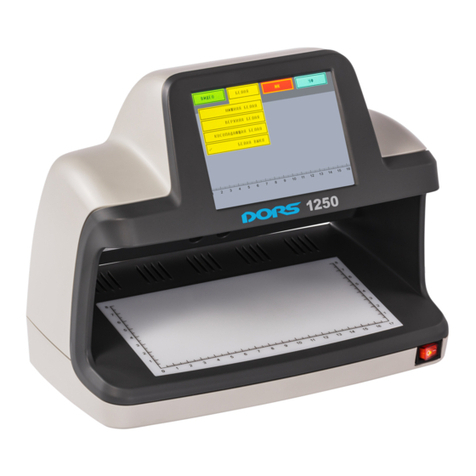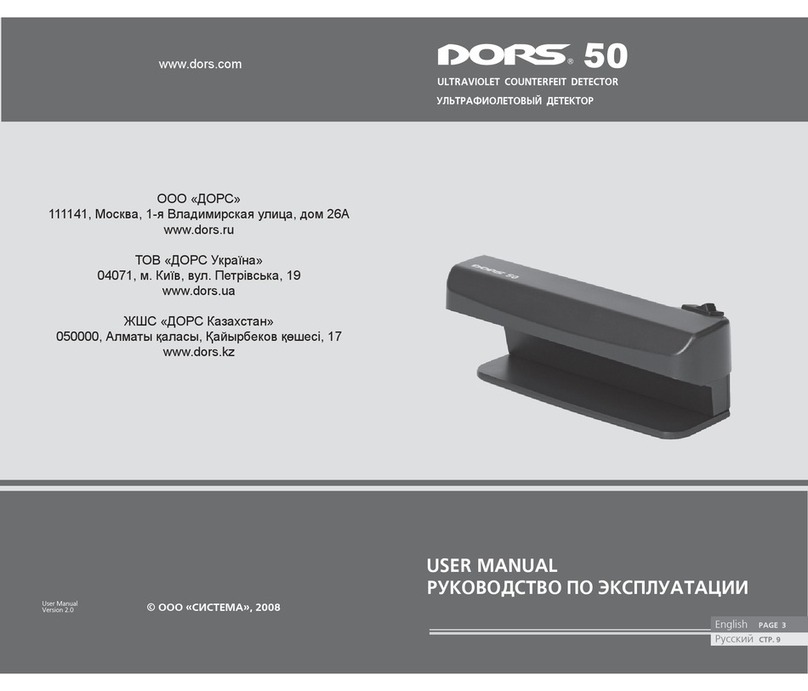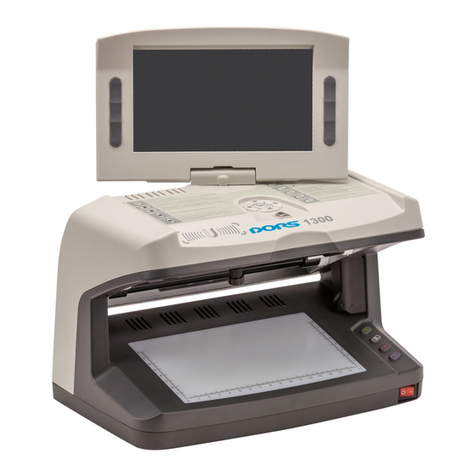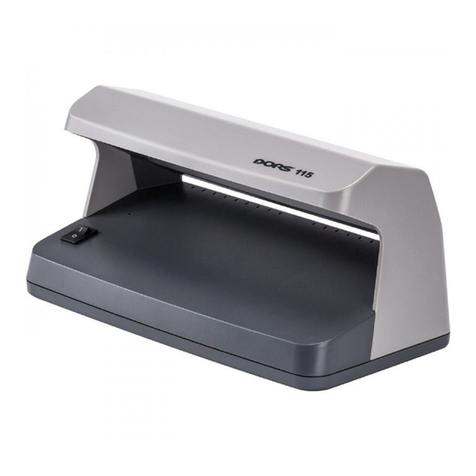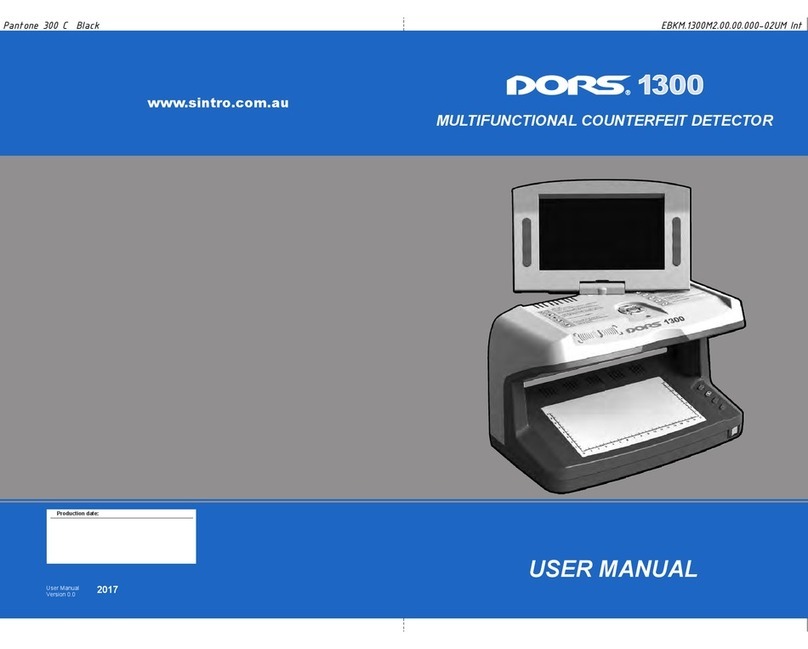
14 15
Magnetic verification:
1. DORS 15When using visualizer
the device can be in any operation
mode.
2. The banknote to be checked and
the device should be placed on a
special mat for verification (provi-
ded in the delivery set of DORS 15).
3. DORS 15Switch on by pressing
any button.
By sho rt-t e rm pre ssin g of t h e
4. Select button select magnetic
verification mode (the button has
green illumination). Put DORS 15
on the banknote in such way that
the area to be checked is under the
sensor. Move the sensor along the
area to be checked and determine
the places of sensor's activation
and non-activation. Sound signal
and glowing indicator inform you
about sensor's activation. Sound
signal can be switched on and off at
-any moment of work. For this pur
pose it is necessary to press and
keep pressed for 2 seconds the
Volume button.
The places of sensor's activation
are magnetic, non-activation - non-
magnetic. In this way location of
magnetic and non-magnetic colors
of the text and drawing is detected
with high accuracy.
5. The received data should be com-
-pared with the location of mag netic
marks on the authentic banknote.
Warning.
The magnetic sensor of DORS 15
-is very sensitive that is why pre
-sence of switched on mobile pho
nes in the range of 2.5 m from the
visualizer may cause false sensor's
activations.
6. DORS 15If was not in use within
-one hour it is automatically switch
ed off.
Remark: If magnetic marks are not
clearly detected during verification
it is necessary to adjust the sensiti-
vity of the sensor. It happens due to
highly scattered magnetic charac-
teristics among the banknotes of
various currencies. Besides this
the banknotes of the same type
may also significantly differ from
each other due to technological
printing peculiarities and due to
banknote's wearing and blotting in
the process of circulation.
If you want to adjust the sensitivity
of the sensor select the required
level of sensitivity by pressing the
Volume button. At this moment red
color illumination of the Volume
button corresponds to the highest
sensitivity, yellow color illumination
- to medium and green color - to the
lowest one. On default at the mo-
ment of switching on the visualizer
switches to the mode it was opera-
ted before the last switching off.
If activates in the areasDORS 15
where shouldn't be any magnetic
marks repeat verification with mini-
mal level of sensitivity. If the device
keeps being activated at the non-
magnetic areas of the banknote or
non-activated at the magnetic are-
as, the banknote may be counter-
feit and it should be verified for the
presence of other features. If the
problem disappears, the banknote
is considered to be authentic but
probably, with printing defects.
The top level of sensitivity is recom-
mended for verification of worn-out
banknotes with insufficient magnetic
effect: the Russian rubles, Euro, US
Dollars, etc.
Ma g ne tic s ens or o f D OR S 15
reliably reacts even on the types of
protection using conductive (including
semi-con-ductive) as well as special
magnetic materials that don't activate
conventional magnetic detectors.
This feature of the magnetic sensor
as well as its high sensitivity should be
taken into account to avoid false acti-
vations. Don't touch the sensitive ele-
ment and metal parts of the device;
avoid mechanical impacts on the
sensor.
Infrared verification:
1. DORS 15When using visualizer
the device can be in any operation
mode.
2. DORS 15Switch on by pressing
any button.
3. Put the device on the banknote in
-such way that the area to be chec
ked is under the sensor.
4. By sho rt-te r m pres s ing of t h e
Select button select IR verification
-mode (the button has red illumi
nation). Move the sensor along the
area to be checked and determine
the places of sensor's activation
and non-activation. Sound signal
and glowing indicator inform you
about sensor's activation. Sound
signal can be switched on and off at
-any moment of work. For this pur
pose it is neces-sary to press and
keep pressed for 2 seconds the
Volume button. Places of sensor's
activation correspond to contrast
areas in IR band, places of non-
activation - to non-contrast.
5. -The received data should be com
-pared with the data of the authen
tic banknote.
6. DORS 15If was not in use within
-one hour it is automatically switch
ed off.
Remark: If IR marks are not clearly
detected during verification it is
necessary to adjust the sensitivity
of the sensor. For this purpose
-select the required level of sensiti
vity by short-term pressings of the
Volume button. The sensitivity level
can be detected according to the
color of the button illumination (see
-the " " paragMagnetic Verification
raph). If there are activations on the
points where it shouldn't happen
-you ought to decrease the sensiti
-vity; if activation is not enough ac
tive in the contrast zones you ought
to increase the sensitivity. The
necessity to adjust the sensitivity is
caused by a wide scatter of this
protective feature among the bank-
notes of different currencies.
Besides this the banknotes of the
same denomination may also signi-
ficantly differ from each other due
to technological printing peculiari-
ties and due to banknote's wearing
and blotting in the process of circu-
lation.
Switch off visualizer byDORS 15
pressing the Select button and
keeping it pressed for 3 seconds.







